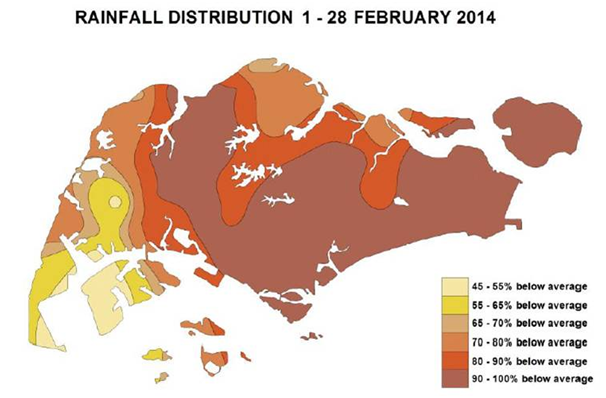JOINT ADVISORY BETWEEN PUB AND NEA
Singapore, 18 November 2014 – Singapore can expect more rainy days ahead with the onset of the Northeast Monsoon later this month, according to the Meteorological Service Singapore (MSS). The first half of November 2014 has been wetter than usual in many parts of the island, with 188mm of rainfall recorded at the Changi climate station. Rainfall for November and December 2014 is expected to be about 20% above the long-term average of 256.6mm and 288.4mm respectively.
2The Northeast Monsoon season typically comprises a wet phase between late November and January, followed by a drier phase in February. The wet phase is characterised by short-duration moderate to heavy thundery showers mainly in the afternoon and evening, and about two to four episodes of monsoon surges. Monsoon surges refer to the steady strengthening of northeasterly winds blowing from the South China Sea. These monsoon surges usually bring periods of prolonged widespread moderate to heavy rain lasting between two and five days, occasionally windy conditions, and cooler temperatures.
3MSS will issue warnings when heavy rain or prolonged monsoon rain is expected, in addition to the regular weather forecast. This will help the public to better prepare for heavy rain. Heavy rain coinciding with high tides could lead to localised flash floods in low-lying areas. The public are advised to exercise caution during the Northeast Monsoon season as flash floods may occur in the event of heavy rainfall.
Enhancing Operational Preparedness
4In preparation for the upcoming Northeast Monsoon, PUB, the national water agency, works closely with NEA’s Department of Public Cleanliness (DPC) to ensure that our drains remain free flowing.
5Apart from reminding the construction industry to conduct checks on the public drains in the vicinity of their respective construction sites, PUB is also inspecting some 100 major construction worksites to ensure that the drains around the construction sites are free of debris and smooth-flowing.
Online Flood Monitoring Efforts
6As part of PUB’s flood monitoring efforts, a network of 161 closed circuit television (CCTV) cameras to monitor road conditions in low-lying areas and hotspots in real time. Some of these CCTV images are also available for the public to view via PUB’s website or PUB’s mobile app MyWaters and they are refreshed every five minutes.
7PUB has increased the number of water level sensors from 158 last year to 171 this year. Installed in the major drains and canals, these water level sensors provide real-time data on water levels, and serve to enhance PUB’s live monitoring of site conditions during heavy storms and enable quick response. PUB will be increasing the number of water level sensors to 200 by the first quarter 2015. Information from all water level sensors is also available for public viewing. The public can subscribe to the free SMS alert service via PUB’s website or get updates on rising water levels in the drains or canals on PUB’s Facebook, Twitter and PUB’s MyWaters mobile app.
Keeping the Public Informed
8In October, PUB officers had distributed flood advisories to some 500 residents and shop-owners in low-lying areas, some of which are subject to tidal influence. Besides alerts on the possibility of flash floods, the advisories also provide tips on the precautions that residents and shop owners could take to protect their belongings, such as by storing them on higher ground or placing sandbags or flood boards to block floodwaters.
9To obtain the latest weather reports, including heavy rain warnings, the public can tune in to radio traffic watch broadcasts, call MSS’ weather forecast hotline at 65427788, visit the NEA website at www.nea.gov.sg and access NEA’s mobile app MyENV or subscribe to the heavy rain warning SMS alert service provided by the MSS.
10During heavy rain events, the public can also be updated on flood alerts through various channels such as PUB’s Facebook at www.facebook.com/PUBsg, PUB’s Twitter at www.twitter.com/PUBsingapore, and PUB’s mobile app MyWaters. Motorists can also look out for flood updates via electronic signage on roads.
11Members of the public can call PUB’s 24-hour Call Centre at 1800-284 6600 to report on any flood situation. The public can also visit PUB’s website at http://www.pub.gov.sg/managingflashfloods to access the CCTV images and information on water levels in key canals and drains.
– End –

